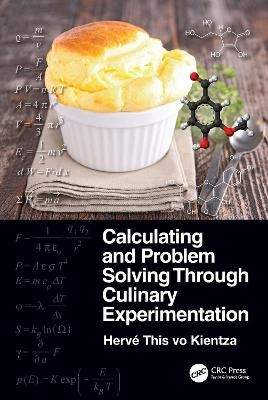
Calculating and Problem Solving Through Culinary Experimentation
CRC Press (Verlag)
978-1-032-28650-1 (ISBN)
Calculating and Problem Solving Through Culinary Experimentation offers an appealing approach to teaching experimental design and scientific calculations.
Given the fact that culinary phenomena need physics and chemistry to be interpreted, there are strong and legitimate reasons for introducing molecular gastronomy in scientific curriculum.
As any scientific discipline, molecular gastronomy is based on experiments (to observe the phenomena to be studied) and calculation (to fit the many data obtained by quantitative characterization of the studied phenomena), but also for making the theoretical work without which no real science is done, including refuting consequences of the introduced theories. Often, no difficult calculations are needed, and many physicists, in particular, make their first steps in understanding phenomena with very crude calculations. Indeed, they simply apply what they learned, before moving to more difficult math.
In this book, the students are invited first to make simple experiments in order to get a clear idea of the (culinary) phenomena that they will be invited to investigate, and then are asked simple questions about the phenomena, for which they have to transform their knowledge into skills, using a clear strategy that is explained throughout. Indeed, the is "problem solving based on experiments", and all this about food and cooking.
Key Features:
Introduces readers to tips for experimental work
Shows how simple scientific knowledge can be applied in understanding questions
Provides a sound method ("strategy") for calculation in physics and chemistry
Presents important definitions and laws for physical chemistry
Gives confidence in one’s calculation skill and problem solving skills
Explore physical and chemical phenomena that occur during cooking
A unique mix of culinary arts and correct calculations, this book is useful to students as well as professors in chemistry, physics, biology, food science and technology.
Hervé This vo Kientza is a physical chemist at INRAE and professor at AgroParisTech. He is the director of the AgroParisTech-INRAE International Centre for Molecular Gastronomy, the head of the INRAE Group of Molecular Gastronomy, the scientific director of the Fondation Science & Culture alimentaire, at the French Academy of Sciences, the president of the Educational Committee of the Institute for Advanced Studies in Gastronomy (University of Reims Champagne Ardennes/Le Cordon bleu), a member of the Steering Committee of the Académie d’Alsace and a scientific advisor of the journal Pour la Science.
Preface. About the Author. Let Us Stand on Our Two Legs. Practical Skills. Theoretical Skills. Calculation. Gases (G). Liquids (L). Foams (G/L Systems). Emulsions (L1/L2). Gels. Suspensions. More Complex Systems. Conclusion. Index.
| Erscheinungsdatum | 02.11.2022 |
|---|---|
| Zusatzinfo | 4 Tables, black and white; 58 Line drawings, color; 6 Line drawings, black and white; 26 Halftones, color; 1 Halftones, black and white; 8 Illustrations, color; 83 Illustrations, black and white |
| Verlagsort | London |
| Sprache | englisch |
| Maße | 178 x 254 mm |
| Gewicht | 660 g |
| Themenwelt | Technik ► Lebensmitteltechnologie |
| Technik ► Umwelttechnik / Biotechnologie | |
| ISBN-10 | 1-032-28650-4 / 1032286504 |
| ISBN-13 | 978-1-032-28650-1 / 9781032286501 |
| Zustand | Neuware |
| Haben Sie eine Frage zum Produkt? |
aus dem Bereich


